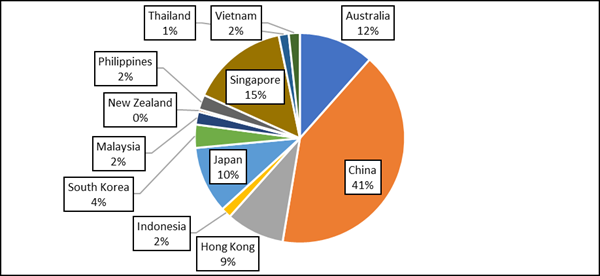Data Centre Growth Rates in the Asia-Pacific Remain Strong With Average Rate of Growth in Data Centre Space, Power and Revenue Forecast for the 4-Year Period to the End of 2026 is to Be 50 Per Cent
The Data Centre markets in the Asia Pacific Region report analyses twelve third-party Data Centre country markets in the region including Australia, China, Hong Kong, Indonesia, Japan, Korea (South), Malaysia, New Zealand, Philippines, Singapore, Thailand and Vietnam.
The Data Centres providers in Asia Pacific region is amongst the fastest growing in the world, with South Korea forecast to have a growth of 100%.
The report looks at the Data Centre developments in the region, including the key metrics of market size, growth, pricing and new investment.
The report also provides a forecast for each of the twelve surveyed countries for the period end of December 2022 to end of December 2026 covering:
- Data Centre space in m2 - 2022 to 2026
- Data Centre Power in MW - 2022 to 2026
- Data Centre utilisation level - 2022 to 2026
- Average rack space, m2 & kw pricing - 2022 to 2026
- Data Centre Revenues Forecast - 2022 to 2026
Some of the key findings include:
Data Centre growth rates in the Asia-Pacific region remain strong. The average rate of growth in Data Centre space, power and revenue forecast for the four-year period to the end of 2026 is to be 50 percent, with South Korea to have a growth rate of over 100 percent for the same period - with Australia and Singapore to have among the lowest growth rates. Australia and Singapore are both mature markets with over 400,000 m2 of installed Data Centre space, and have attracted a range of hyperscale and cloud investments. Singapore is constrained by a shortage of power and land for Data Centre development with power being rationed by the Government.
New Data Centres are mostly being built in Metro city areas: The Metro city area is attractive as it is close to large population centres - with around half of the Data Centre power in the 12 Asia Pacific country markets being located in 17 Data Centre city clusters.
The existing Data Centre locations (particularly Singapore & Hong Kong) face challenges: Singapore and Hong Kong both face power constraints, with most power being imported with limited renewable power capacity. The constraints on developments in Singapore & Hong Kong provide an opportunity for other markets:
The Australian Data Centre market has become one of the largest in Asia: Australia has benefitted from the creation of large campus Data Centres in the Melbourne and Sydney areas, with AirTrunk (Melbourne) developing three campuses with up to 370 MW of power in total and NEXT DC (Melbourne) also developing two campuses with up to 120 MW of power.
The Asia Pacific market is being powered by demand for the cloud: Cloud expansion is underpinning the business case for Data Centre construction leading to demand for new hyperscale facilities. The entry of new investors including private equity investors and Data Centre Providers is spurring development in new hyperscale facilities.
There is some uncertainty about future Data Centre pricing and the revenue outlook: Overall the analyst forecasts that Asia Pacific Data Centre pricing will continue to rise despite the increase in new space and facilities taking place.
Geographical coverage
- Australia
- China
- Hong Kong
- Indonesia
- Japan
- South Korea
- Malaysia
- New Zealand
- Philippines
- Singapore
- Thailand
- Vietnam
Special Offer: Any-one purchasing the Asia-Pacific Data Centre Landscape Report 2022 to 2026, will receive a complimentary copy of the 30-page report covering the new Data Centre Developments in the Asia-Pacific Region announced during the last 12 months ending July 2022 covering details of some 60 announcements made by 48 Data Centre Providers.
Table of Contents
- Methodology used in the report
- Executive Summary
Executive Summary
The latest research covering the Asia-Pacific region reveals that the Data Centre growth rates in the Asia Pacific remain strong with average rate of growth in Data Centre space, power and revenue forecast for the four-year period to the end of 2026 is to be 50 percent.
The analyst forecasts that China will account for 41 percent of Data Centre revenues in the Asia Pacific region, followed by Singapore, Australia and Japan being the next highest markets (in percentage terms), table below shows the Data Centre revenues forecast for each of the twelve surveyed countries.
This 120+ page report covers twelve countries namely Australia, China, Hong Kong, Indonesia, Japan, Korea (South), Malaysia, New Zealand, Philippines, Singapore, Thailand and Vietnam.
The Data Centre Asia-Pacific Landscape report - 2022 to 2026 provides a unique survey of the third-party Data Centre market in twelve Asia-Pacific countries.
Part I examines the top ten in the region from the end of 2022 to the end of 2026, with Part II providing Data Centre space, power, key providers & new developments with Part III providing a forecast for each surveyed country.
Methodology
The analyst researches its reports typically within a three-month period. All of its reports are based on primary and secondary research including interviews with relevant companies/operators covered in the report. The analyst also draws on its extensive in-house database and its contacts in the field of telecommunications it has established since the company was launched in 2006.
The analyst has 26-years of experience in the field of telecoms pricing both mobile and fixed. They have a network of consultants as well as a multi-lingual research team, with languages spoken French, German, Polish and Spanish.

LOADING...









